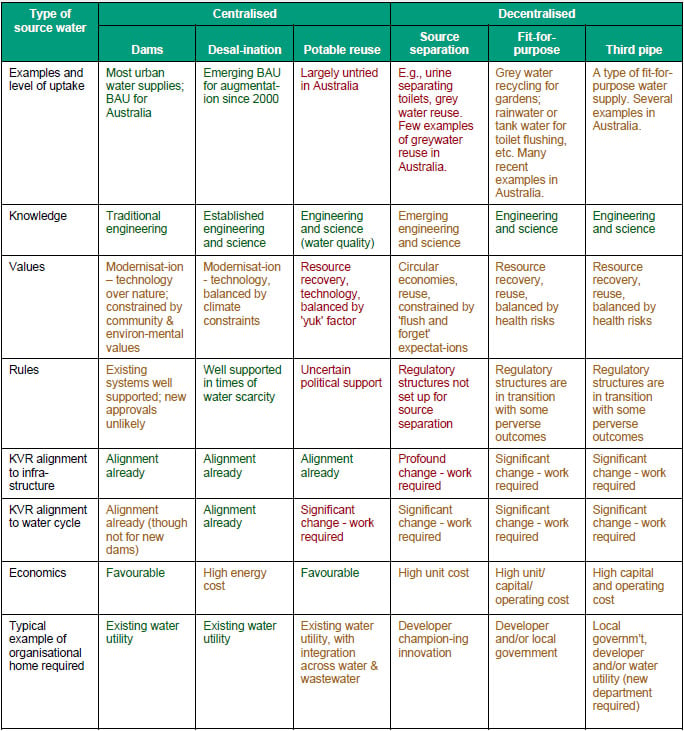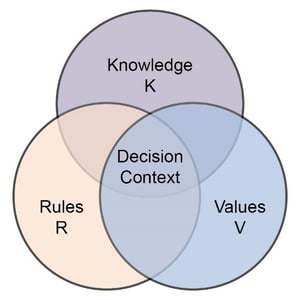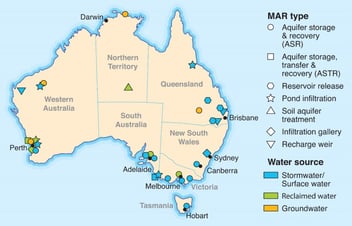Third pipe water recycling

By D Livingston.
First published in Water e-Journal Vol 5 No 3 2020.
Abstract
Third pipe systems for recycled water are on the periphery of options for more resilient urban water management in the face of water scarcity. A number of schemes in the Australian water industry provide useful learnings. Even though direct supply costs are often higher than the potable water price, there are distinct circumstances where such schemes can be justified economically. Even where schemes have not been economic, there can be valuable lessons around the institutional alignment required to enable innovation for integrated urban water management.
Introduction
Third pipe recycled water systems have been implemented in a range of new developments throughout Australia over the past two decades. Such systems are known as ‘third pipe’ or ‘dual reticulation’ schemes because a piped network additional to the water and sewerage pipe networks carries recycled wastewater to households. This approach to recycling wastewater is typically driven by water scarcity, effluent management constraints and/or regulatory incentives for alternative water sources.
Third pipe recycled water systems have not been widely implemented because the value of the perceived benefits typically do not outweigh the high capital and ongoing costs associated with such systems. Some third pipe systems have even been discontinued because of economic viability concerns. Further, there is a significant human health and reputation risk from illegal cross-connections (West et al., 2015; Dennis, 2020).
Planning regulations (such as BASIX in NSW) incentivise or require alternative water sources such as rainwater tanks or third pipe recycled water solutions to reduce potable water demand and thus obtain development approval. Typically rainwater tanks are a cheaper way for developers to satisfy such regulations; but sometimes third pipe dual reticulation is offered up as a competitive alternative (Australian Building Codes Board, 2016).
This paper outlines useful lessons that can be learned from past experience with third pipe systems, including quantitative Australian water industry data on costs and benefits, cross connections, scale and age of existing implementations, cost per kilolitre, etc.
In addition, qualitative case studies of the institutional alignment (also referred to as alignment of values, knowledge, rules) demonstrate there are valuable learnings and features that can be replicated even from cases where third pipe systems have been discontinued due to high cost.
Methods
This paper is based on recent personal communication and literature review within Australian urban water utilities conducted by the author, as well as PhD research conducted by the author approximately 15 years ago (Livingston, 2008). The PhD research used case studies, interviews and surveys to look at institutional enablers and barriers to the uptake of more closed loop forms of urban water management, including case studies of third pipe systems.
Results
Economics of third pipe systems
Third pipe systems have significant additional cost compared to conventional potable water supplies because of factors including:
- Duplication of infrastructure (capital and operating costs);
- Cross-connection risk (increasing monitoring requirements and cost);
- Limited demand for the recycled water (in some cases little more than toilet flushing, reducing the potential to achieve lower average costs through greater scale).
This has resulted in levelised cost for dual reticulated recycled water being well above that of potable water for most, or possibly even all, third pipe schemes (West et al., 2015). This outcome is exacerbated by ‘postage stamp’ pricing policies for potable water whereby all small customers pay the same regulated price for water regardless of their distance from the source and their specific supply cost.
The economic viability of supplying recycled water is reduced even further when, as is typically the case, the price customers pay for recycled water is less than potable.
Full cost recovery is often only achievable if there are significant avoided effluent management costs or the upfront developer contribution can cover the customer pricing shortfall over the life of the scheme. Developer contributions are usually insufficient for full cost recovery, however.
The Rouse Hill third pipe water recycling project was enabled by a combination of developer contributions; a scheme of significant scale with large lot sizes leading to strong recycled water demand; and factoring in avoided costs into the economic assessment. Algal blooms in the Hawkesbury Nepean River system triggered tightening nutrient discharge limits that would otherwise have required significant capital cost for treatment upgrades.
In most cases, the public utility (and ultimately the government shareholder) subsidises the scheme.
The economic viability of various Australian schemes has been reviewed in much more detail by West et al. (2015) than in this paper. Table 1 provides a snapshot of key data from noteworthy schemes. It is important to note that every scheme has a different context and direct comparison is difficult (GHD, 2018).
Where water is scarce (e.g. in times of drought) the value of recycled water to the community increases. Thus third pipe recycled water can be economically viable in certain situations. External benefits, avoided costs and/or customer willingness to pay may be able to be used to obtain a favourable cost benefit analysis.
While relatively untried in Australia, potable (direct or indirect) water recycling is often thought to be a more economically viable way of decreasing the stress on potable supplies. Using recycled water to augment the potable supply is anticipated to cost far less overall (Personal communication, 2020), even with increased treatment requirements, because piped network infrastructure does not need to be duplicated.
Accounting for overly optimistic cost benefit analyses
While every scheme has different characteristics and context, some of the common factors that have contributed to costs being higher than initially anticipated (or benefits being lower) include:
- Lower than anticipated subscription rates (slower development and/or extent of scheme reduced) (West et al., 2015);
- Decreasing lot sizes (meaning less outdoor use) (Gold Coast City Council, 2013);
- Increased risk mitigation costs (preventing and managing cross connections) (Personal communication, 2020; Dennis, 2020);
- Increased regulatory requirements (e.g. inspections, monitoring) (Gold Coast City Council, 2013);
- Decreased usage due to water efficiency gains or health regulations (e.g. no washing machine use) (Gold Coast City Council, 2013).
While smaller schemes do not have the advantages of economies of scale, experience in Australia demonstrates there is a significant risk of sunk assets when planning large third pipe schemes. Any optimistic assumptions in the economic assessment of larger schemes can be amplified such that unviable economics can become quite burdensome for the entity subsidising the scheme.
The Gold Coast Pimpama Coomera third pipe scheme is the most prominent scheme to be decommissioned, due to a cost benefit gap of around $100m (Dennis, 2020; Gold Coast City Council, 2013).
The Rouse Hill scheme in Sydney, on the other hand, is the most prominent third pipe scheme still remaining 25 years after commissioning. Its viability reflects the interplay of water supply considerations, pricing, developer contributions and the avoided cost of upgrades to local wastewater treatment and discharge.
It should be noted that just as there are biased economic analyses that may optimistically present dual reticulation more favourably than reality, there is also evidence that conventional water and wastewater investment is also favoured by a ‘status quo’ bias combined with optimism bias in economic analysis. Optimism bias, in the case of conventional systems, is less likely to be scrutinised later (Watson et al., 2018; Livingston, 2008).
It is unsurprising that there is a diversity of views in the Australian water industry regarding the long-term viability of third pipe systems. Table 2 gives a snapshot of some of the sentiments expressed in personal communication with people working in water utilities and consulting firms across the east coast of Australia.
 Table 2: Comments from within Australian water industry regarding third pipe water recycling schemes (comments made in 2019/20)
Table 2: Comments from within Australian water industry regarding third pipe water recycling schemes (comments made in 2019/20)
Lessons learned from Gold Coast Pimpama Coomera Scheme
The Gold Coast Pimpama Coomera Waterfuture project was the largest integrated urban water management project of its type in Australia. Dual reticulation was one of several sustainable water management initiatives such as rainwater tanks and stormwater harvesting. It was considered a shining light in the early 2000s (Livingston, 2008). But in 2014 the third pipe recycled water supply was decommissioned on economic grounds (Gold Coast City Council, 2013).
Total infrastructure costs exceeded business case estimates; operating costs also exceeded expectations; and revenue did not meet expectations. An economic review by Marsden Jacobs in 2013 projected a $100m disbenefit to society if the scheme was continued, not including sunk costs (Gold Coast City Council, 2013).
Queensland Health required significantly more inspections and testing than anticipated, and also ruled that the recycled water could not be used for washing machines. This meant the recycled water could only be used for toilet flushing and at one outside tap per house. Smaller lot sizes than anticipated also led to reduced outdoor usage. Further, house construction rates did not match expected projected growth rates for the development.
Queensland Health also had a strict requirement on UV transmissivity (UVT) of 70%. The treatment system would regularly miss that target, leading to retreatment of a third of flow on average (West et al., 2015).
These adverse cost and benefit outcomes were not the only change leading to abandonment of the scheme. The Queensland Development Code was amended in 2013 such that alternative water supplies (including rainwater tanks) were no longer required for development approval (Australian Building Codes Board, 2016). This was following an independent review by the Queensland Competition Authority (QCA) that determined the costs of mandating alternative water supplies outweighed the benefits.
On discontinuation of the dual reticulated recycled water service, Gold Coast City Council has refocused the scheme to providing recycled water for public space irrigation. This uses up to an order of magnitude more water at less overall cost compared to the previous third pipe system (Personal communication, 2020).
While there is a significant amount of sunk capital in the third pipe reticulation infrastructure, the transformed system is generally regarded as a good salvaged outcome for the Gold Coast. Most of the original Waterfuture project team and advisory committee have reportedly embraced the new recycled water strategy (Personal communication, 2020), without considering the initial master plan a failure.
Many of the learnings (both positive and negative) from the original project planning have been taken into this new recycling strategy. Significant positive learnings have been taken forward in the area of stakeholder collaboration and communication.
The Pimpama Coomera Waterfuture case highlights the importance of alignment of values, rules and knowledge (VRK) in the decision-making context (Livingston, 2008). The VRK framework is used in adaptive pathways environmental planning (Gorddard et al., 2016) and also in the water industry (e.g. Melbourne Water Corporation, 2018).
The VRK framework stresses the greatest potential for options where knowledge, values and rules are aligned (see Figure 1).
For Gold Coast City Council to be able to get the Pimpama Coomera Waterfuture project through planning, delivery and into the operational phase for around a decade, significant alignment of VRK was required. This was created through networking, leadership, partnerships with stakeholders including the community and creation of a new organisational home.
The Waterfuture team at Gold Coast City Council provided the organisational home to sustain the newly aligned VRK (Livingston, 2008). This alignment of VRK allowed significant innovation to happen and be sustained over more than a decade. The millennium drought helped pave the way for the initial enthusiasm for the project, with a key driver being that the scheme was to supply 5% of overall water demand by 2056 (Gold Coast City Council, 2013).
The presence of the development planning and approval function within the same organisation as water and sewerage (all within Gold Coast City Council) was also a key factor enabling alignment for the Pimpama Coomera Waterfuture project to get off the ground (Livingston, 2008).
However, with the passage of time, the end of the millennium drought, changes to personnel and restructures of both government departments and the Queensland water industry, the alignment of VRK was eroded. A notable example of this lack of alignment was the mismatched expectations with Queensland Health resulting in increased costs and eroded benefits of the scheme.
The Pimpama Coomera case provides valuable insight into how VRK alignment can enable innovation, but is also required to be sustained for the long-term sustainability of innovation. It is worth noting, however, that the misalignment of VRK may not have been the only factor that caused the abandonment of the third pipe scheme.
Economic viability may still have been a challenge even if VRK alignment was optimised and maintained. However, the economic assessment would have been much more favourable (or less unfavourable) if VRK alignment was maintained (e.g. with Queensland Health). The extent of the economic benefit if VRK alignment hypothetically persisted is impossible to accurately quantify.
Discussion
Future pathways for enabling water recycling
Reflecting on experience in the Australian water industry, large scale dual reticulation is widely perceived to be an expensive duplication of infrastructure for essentially a duplication of household water product and service provision.
Levelised cost comparisons show third pipe water recycling as sub-optimal in many situations; however, there still can be situations where planning requirements, wastewater treatment and disposal costs and/or water scarcity may make it a viable alternative. It is currently being actively pursued by some utilities (Personal communication, 2020).
There is arguably insufficient evidence to entirely rule out dual reticulation as an option for future water recycling. Dual reticulation does present a significant risk of sunk capital. While this risk has been realised in some cases as reviewed, those cases still provide valuable learnings for the ongoing search for more sustainable, integrated and resilient urban water management.
Much good work is being done across the Australian water industry in seeking resilient water sources for our constrained future. Where and how dual reticulation fits into that future depends on the continued collaboration of the water industry working together with its stakeholders to determine the relative amounts of investment to be made in each of the pathways outlined in Table 3.
 Table 3: Alternative water sources with respective alignment of knowledge, values and rules. (Traffic light colours show the level of alignment / support for each option in each category.)
Table 3: Alternative water sources with respective alignment of knowledge, values and rules. (Traffic light colours show the level of alignment / support for each option in each category.)
As shown in Table 3, the attention needed for alignment of VRK should be in proportion to both the infrastructure change and the water cycle change proposed. For example, potable reuse does not represent much of an infrastructure change, but it is a significant change to the water cycle. Thus for potable reuse to have a chance of being successful, significant attention needs to be paid to the knowledge, values and rules around the water cycle.
Dual reticulation, on the other hand, is a change to both infrastructure and water cycle. Thus the VRK alignment challenge may be potentially even more complex than for potable reuse over the long term, as VRK alignment is needed in both domains (infrastructure and water cycle). However, if done on a decentralised basis (or for smaller developments), the VRK alignment challenge can be scaled down accordingly.
Of course, potable reuse has a more significant community value and political support hurdle to overcome than third pipe water recycling, due to the overwhelming ‘yuk factor’ associated with potable reuse (Hurlimann & Dolnicar, 2010).
Conclusion
Third pipe systems have had a chequered history in terms of economic viability and cross connections. Nevertheless, both the extant and discontinued schemes provide useful examples of how innovation for integrated urban water management can be enabled.
Ensuring alignment of values, rules and knowledge is a key step in enabling innovation. Creating an organisational home to embed that alignment can be key to sustaining improved ways of managing the urban water cycle.
Acknowledgements
This paper is the result of collaboration and consultation with a number of colleagues at Hunter Water Corporation, Hunter H2O, and a number of other utilities and consultancies in the Australian water industry.
About the author
Daniel Livingston | Daniel Livingston currently works at Hunter Water Corporation where he is the Team Leader for the Sustainable Wastewater team, developing strategy in wastewater and energy for Hunter Water.
References
Australian Building Codes Board. (2016). Rainwater harvesting and Use. Canberra: ABCB.
Dennis, P. (2020). Dual reticulation (third pipe) review. Newcastle: Hunter H2O.
GHD. (2018). 2020 Lower Hunter Water Plan Gap Analysis: Centralised Recycled Water Report. Newcastle: GHD.
Gold Coast City Council. (2013). Adopted Report No. 671 of the Water Services Committee Meeting held on 11 December 2013. Gold Coast City Council.
Gorddard, R., Colloff, M. J., Wise, R. M., Ware, D., & Dunlap, M. (2016). Values, rules and knowledge: Adaptation as change in the decision context. Environmental Science & Policy, 57, 60-69.
Hurlimann, A., & Dolnicar, S. (2010). When public opposition defeats alternative water projects – The case of Toowoomba Australia. Water Research, 44(1), 287-297.
Livingston, D. (2008). Institutions and Decentralised Urban Water Management. Sydney: University of NSW.
Melbourne Water Corporation. (2018). Melbourne Sewerage Strategy. Melbourne Water Corporation.
Watson, R., Prentice, E., Fane, S., & Mitchell, C. (2018). Barriers and opportunities for recycled water and integrated water management investment: Synthesis Report. Prepared for Hunter Water. Sydney: Institute for Sustainable Futures.
West, C., Kenway, S., & Yuan, Z. (2015). Risks to the long-term viability of residential nonpotable water schemes: a review. Melbourne: Cooperative Research Centre for Water Sensitive Cities.



